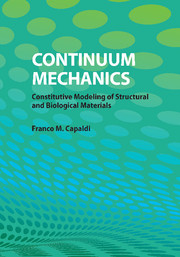10 - Parameter Estimation and Curve Fitting
Published online by Cambridge University Press: 05 August 2012
Summary
As we have seen in this textbook, constitutive models have many material parameters that must be determined experimentally. These parameters are often found by fitting the model's predicted behavior to the experimentally observed behavior. It is critical that the uncertainty in these material parameters be reported along with the values of the parameters. In this chapter, we introduce the methodology for providing uncertainty estimates for experimental measurements and for parameters obtained from curve fitting.
Propagation of Error
Experimental measurements suffer from both systematic and random error. For example, measurements from a force transducer used to measure load have systematic and random error due to the physical sensor and the data acquisition system used to acquire data. The error in the force measurements due to the sensor is a combination of systematic uncertainty due to nonlinearity and hysteresis of the sensor and random uncertainties due to thermal-stability error and repeatability error. The error from the data acquisition system is a combination of systematic uncertainty due to nonlinearity and gain error and random uncertainty due to quantization and noise. Often these errors are well documented by the producers of the measurement equipment. However, one must often take experimentally determined values and combine or manipulate them to report calculated quantities. For example, one might report a stress that was computed using a force measurement and measurement of the cross-sectional area of a specimen. In order to compute the error for a computed quantity that is a function of the distance or force measurement, we will need to propagate these errors through the equations used to compute the desired quantities.
- Type
- Chapter
- Information
- Continuum MechanicsConstitutive Modeling of Structural and Biological Materials, pp. 258 - 268Publisher: Cambridge University PressPrint publication year: 2012



